Comprehensive Marketing Plan for Fairphone in the Australian Market
VerifiedAdded on 2023/01/18
|17
|3573
|48
Report
AI Summary
This report presents a comprehensive marketing plan for Fairphone, a sustainable smartphone company, focusing on its potential entry into the Australian market. The study begins with an executive summary and company profile, including Fairphone's mission and product details. A thorough literature review follows, exploring the situational analysis, including PEST analysis (political, environmental, social-cultural, and technological factors), and internal analysis (employee, customer, competitor, and supplier issues). The report then conducts a SWOT analysis to identify strengths, weaknesses, opportunities, and threats. Market segmentation, targeting, and positioning are discussed, considering geographic, demographic, behavioral, and psychographic factors. The marketing objectives and a description of a new product are outlined, followed by a detailed marketing mix strategy (product, price, place, and promotion) and an implementation plan, including a timeline and budget. The report concludes with a summary of key findings and a list of references.

Running header
Name:
Institution:
Title:
Name:
Institution:
Title:
Paraphrase This Document
Need a fresh take? Get an instant paraphrase of this document with our AI Paraphraser
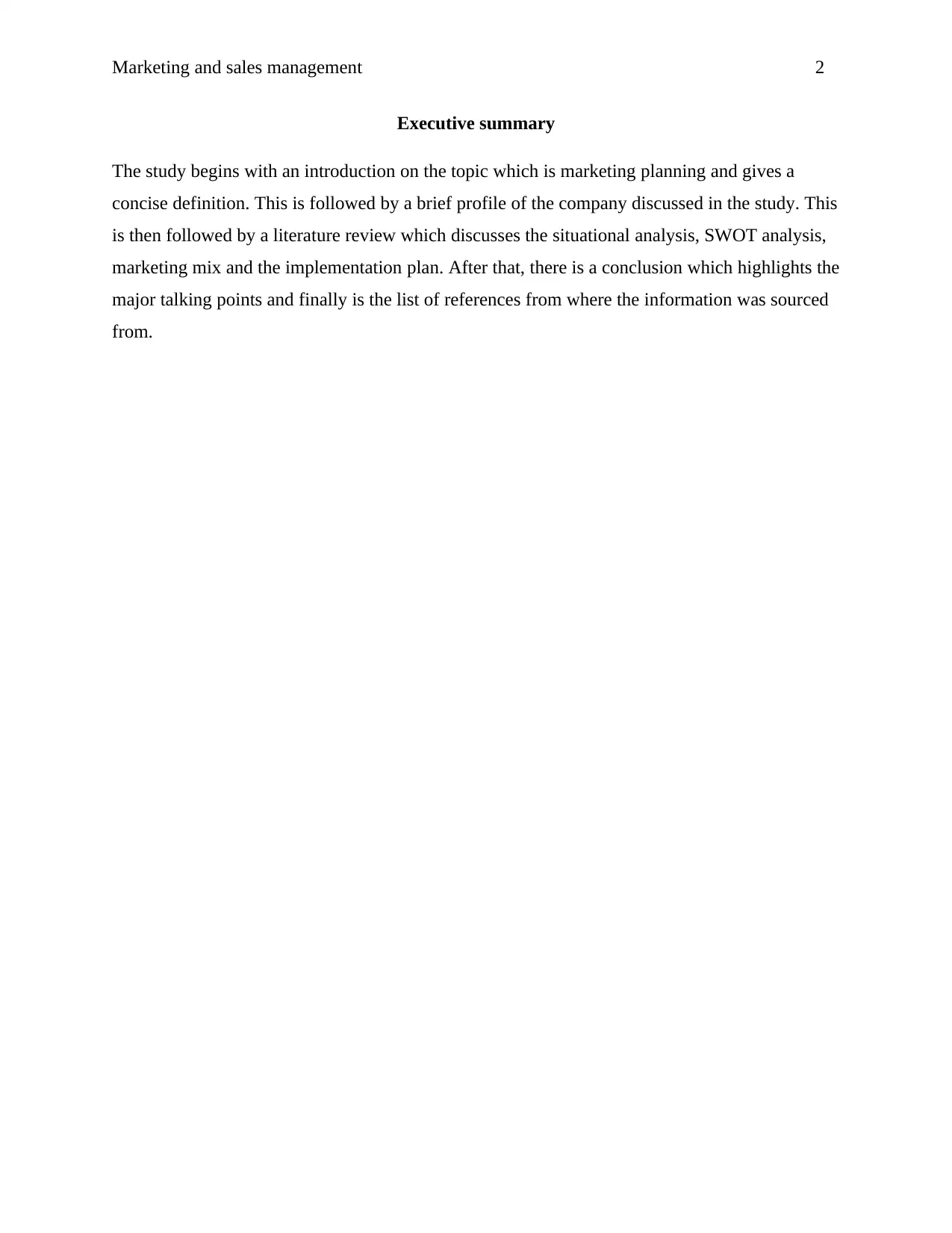
Marketing and sales management 2
Executive summary
The study begins with an introduction on the topic which is marketing planning and gives a
concise definition. This is followed by a brief profile of the company discussed in the study. This
is then followed by a literature review which discusses the situational analysis, SWOT analysis,
marketing mix and the implementation plan. After that, there is a conclusion which highlights the
major talking points and finally is the list of references from where the information was sourced
from.
Executive summary
The study begins with an introduction on the topic which is marketing planning and gives a
concise definition. This is followed by a brief profile of the company discussed in the study. This
is then followed by a literature review which discusses the situational analysis, SWOT analysis,
marketing mix and the implementation plan. After that, there is a conclusion which highlights the
major talking points and finally is the list of references from where the information was sourced
from.
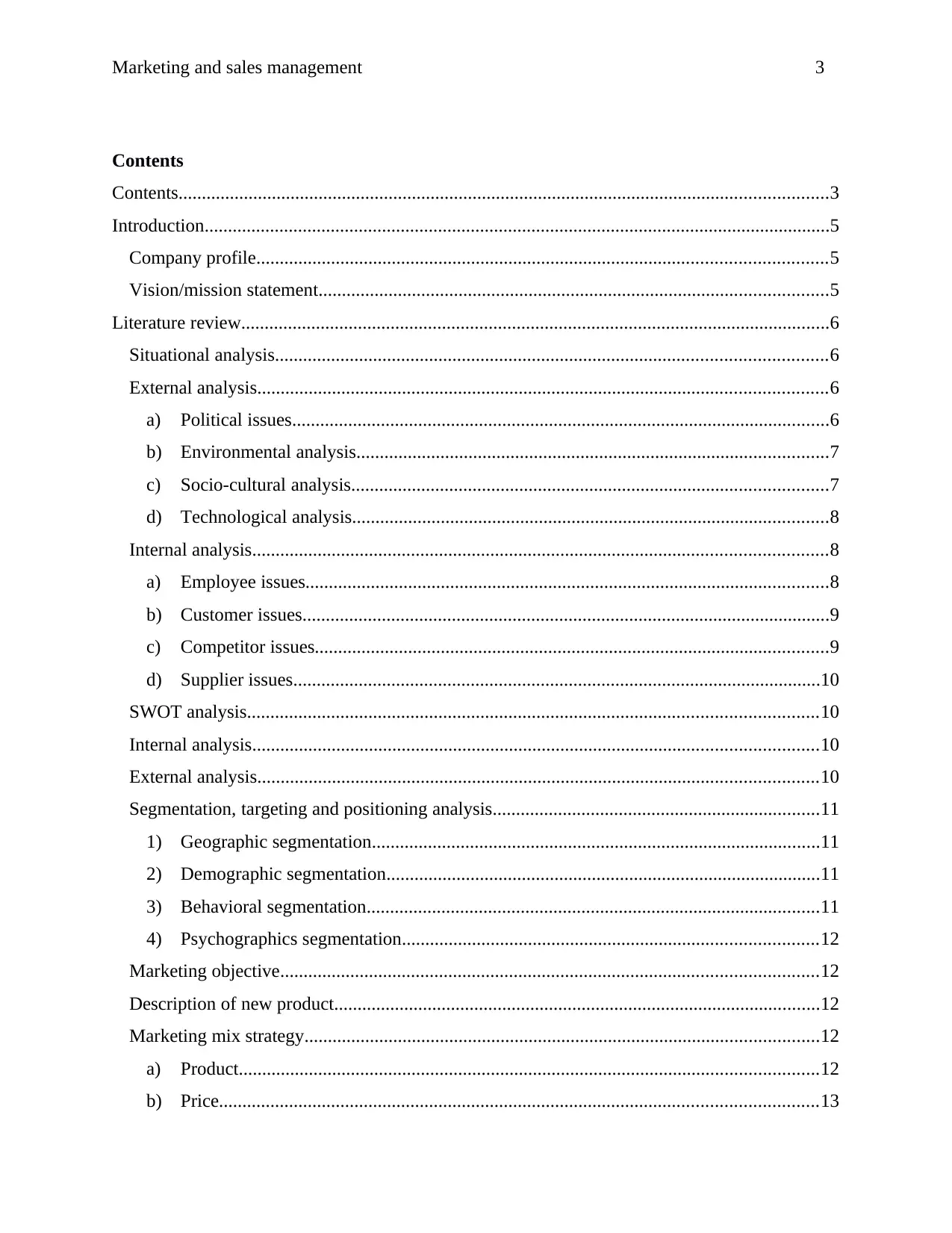
Marketing and sales management 3
Contents
Contents...........................................................................................................................................3
Introduction......................................................................................................................................5
Company profile..........................................................................................................................5
Vision/mission statement.............................................................................................................5
Literature review..............................................................................................................................6
Situational analysis......................................................................................................................6
External analysis..........................................................................................................................6
a) Political issues...................................................................................................................6
b) Environmental analysis.....................................................................................................7
c) Socio-cultural analysis......................................................................................................7
d) Technological analysis......................................................................................................8
Internal analysis...........................................................................................................................8
a) Employee issues................................................................................................................8
b) Customer issues.................................................................................................................9
c) Competitor issues..............................................................................................................9
d) Supplier issues.................................................................................................................10
SWOT analysis..........................................................................................................................10
Internal analysis.........................................................................................................................10
External analysis........................................................................................................................10
Segmentation, targeting and positioning analysis......................................................................11
1) Geographic segmentation................................................................................................11
2) Demographic segmentation.............................................................................................11
3) Behavioral segmentation.................................................................................................11
4) Psychographics segmentation.........................................................................................12
Marketing objective...................................................................................................................12
Description of new product........................................................................................................12
Marketing mix strategy..............................................................................................................12
a) Product............................................................................................................................12
b) Price................................................................................................................................13
Contents
Contents...........................................................................................................................................3
Introduction......................................................................................................................................5
Company profile..........................................................................................................................5
Vision/mission statement.............................................................................................................5
Literature review..............................................................................................................................6
Situational analysis......................................................................................................................6
External analysis..........................................................................................................................6
a) Political issues...................................................................................................................6
b) Environmental analysis.....................................................................................................7
c) Socio-cultural analysis......................................................................................................7
d) Technological analysis......................................................................................................8
Internal analysis...........................................................................................................................8
a) Employee issues................................................................................................................8
b) Customer issues.................................................................................................................9
c) Competitor issues..............................................................................................................9
d) Supplier issues.................................................................................................................10
SWOT analysis..........................................................................................................................10
Internal analysis.........................................................................................................................10
External analysis........................................................................................................................10
Segmentation, targeting and positioning analysis......................................................................11
1) Geographic segmentation................................................................................................11
2) Demographic segmentation.............................................................................................11
3) Behavioral segmentation.................................................................................................11
4) Psychographics segmentation.........................................................................................12
Marketing objective...................................................................................................................12
Description of new product........................................................................................................12
Marketing mix strategy..............................................................................................................12
a) Product............................................................................................................................12
b) Price................................................................................................................................13
⊘ This is a preview!⊘
Do you want full access?
Subscribe today to unlock all pages.

Trusted by 1+ million students worldwide

Marketing and sales management 4
c) Place................................................................................................................................13
d) Promotion........................................................................................................................13
Implementation plan..................................................................................................................14
Time flame.............................................................................................................................14
Budget....................................................................................................................................14
Conclusion.....................................................................................................................................15
Referencing....................................................................................................................................16
c) Place................................................................................................................................13
d) Promotion........................................................................................................................13
Implementation plan..................................................................................................................14
Time flame.............................................................................................................................14
Budget....................................................................................................................................14
Conclusion.....................................................................................................................................15
Referencing....................................................................................................................................16
Paraphrase This Document
Need a fresh take? Get an instant paraphrase of this document with our AI Paraphraser
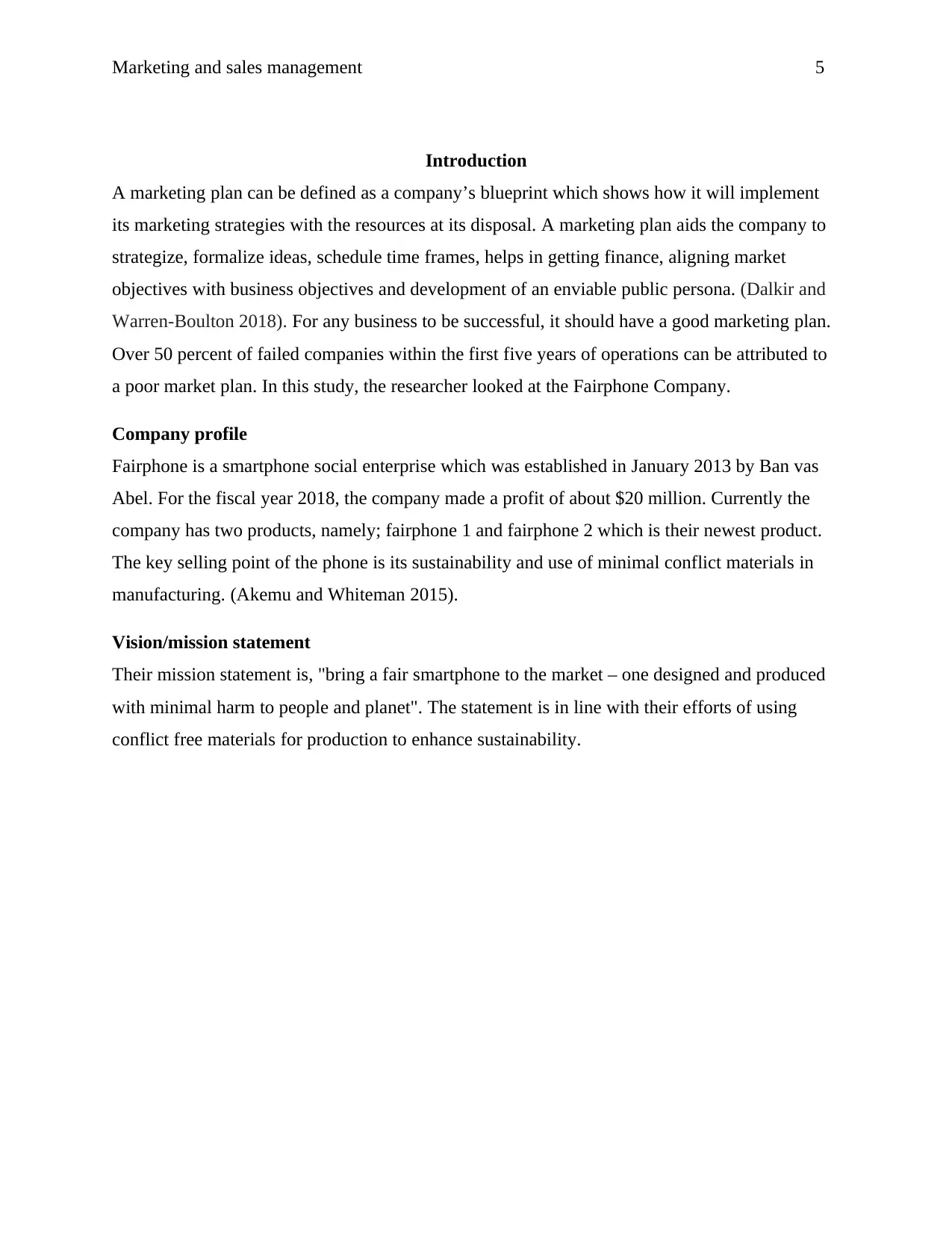
Marketing and sales management 5
Introduction
A marketing plan can be defined as a company’s blueprint which shows how it will implement
its marketing strategies with the resources at its disposal. A marketing plan aids the company to
strategize, formalize ideas, schedule time frames, helps in getting finance, aligning market
objectives with business objectives and development of an enviable public persona. (Dalkir and
Warren-Boulton 2018). For any business to be successful, it should have a good marketing plan.
Over 50 percent of failed companies within the first five years of operations can be attributed to
a poor market plan. In this study, the researcher looked at the Fairphone Company.
Company profile
Fairphone is a smartphone social enterprise which was established in January 2013 by Ban vas
Abel. For the fiscal year 2018, the company made a profit of about $20 million. Currently the
company has two products, namely; fairphone 1 and fairphone 2 which is their newest product.
The key selling point of the phone is its sustainability and use of minimal conflict materials in
manufacturing. (Akemu and Whiteman 2015).
Vision/mission statement
Their mission statement is, "bring a fair smartphone to the market – one designed and produced
with minimal harm to people and planet". The statement is in line with their efforts of using
conflict free materials for production to enhance sustainability.
Introduction
A marketing plan can be defined as a company’s blueprint which shows how it will implement
its marketing strategies with the resources at its disposal. A marketing plan aids the company to
strategize, formalize ideas, schedule time frames, helps in getting finance, aligning market
objectives with business objectives and development of an enviable public persona. (Dalkir and
Warren-Boulton 2018). For any business to be successful, it should have a good marketing plan.
Over 50 percent of failed companies within the first five years of operations can be attributed to
a poor market plan. In this study, the researcher looked at the Fairphone Company.
Company profile
Fairphone is a smartphone social enterprise which was established in January 2013 by Ban vas
Abel. For the fiscal year 2018, the company made a profit of about $20 million. Currently the
company has two products, namely; fairphone 1 and fairphone 2 which is their newest product.
The key selling point of the phone is its sustainability and use of minimal conflict materials in
manufacturing. (Akemu and Whiteman 2015).
Vision/mission statement
Their mission statement is, "bring a fair smartphone to the market – one designed and produced
with minimal harm to people and planet". The statement is in line with their efforts of using
conflict free materials for production to enhance sustainability.
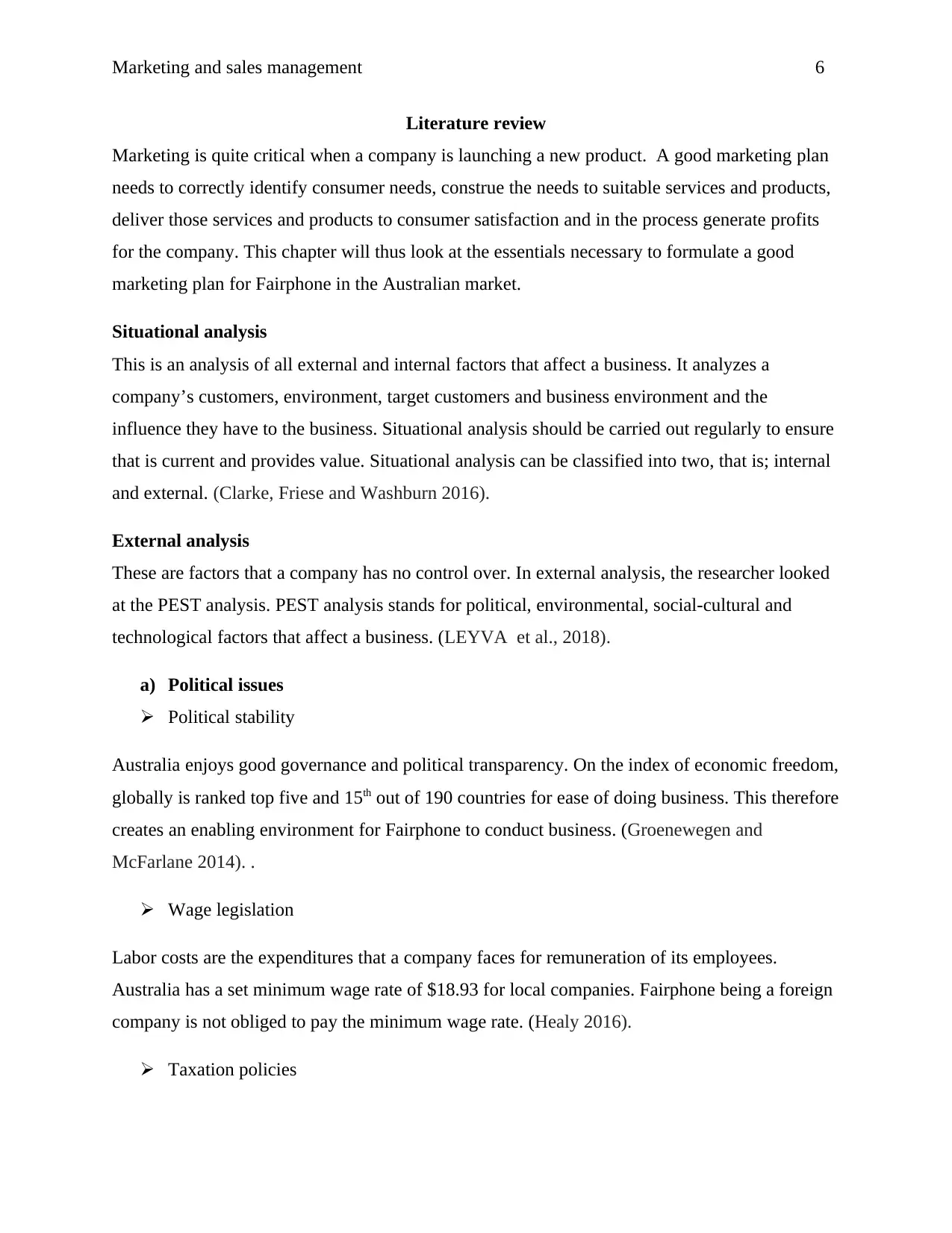
Marketing and sales management 6
Literature review
Marketing is quite critical when a company is launching a new product. A good marketing plan
needs to correctly identify consumer needs, construe the needs to suitable services and products,
deliver those services and products to consumer satisfaction and in the process generate profits
for the company. This chapter will thus look at the essentials necessary to formulate a good
marketing plan for Fairphone in the Australian market.
Situational analysis
This is an analysis of all external and internal factors that affect a business. It analyzes a
company’s customers, environment, target customers and business environment and the
influence they have to the business. Situational analysis should be carried out regularly to ensure
that is current and provides value. Situational analysis can be classified into two, that is; internal
and external. (Clarke, Friese and Washburn 2016).
External analysis
These are factors that a company has no control over. In external analysis, the researcher looked
at the PEST analysis. PEST analysis stands for political, environmental, social-cultural and
technological factors that affect a business. (LEYVA et al., 2018).
a) Political issues
Political stability
Australia enjoys good governance and political transparency. On the index of economic freedom,
globally is ranked top five and 15th out of 190 countries for ease of doing business. This therefore
creates an enabling environment for Fairphone to conduct business. (Groenewegen and
McFarlane 2014). .
Wage legislation
Labor costs are the expenditures that a company faces for remuneration of its employees.
Australia has a set minimum wage rate of $18.93 for local companies. Fairphone being a foreign
company is not obliged to pay the minimum wage rate. (Healy 2016).
Taxation policies
Literature review
Marketing is quite critical when a company is launching a new product. A good marketing plan
needs to correctly identify consumer needs, construe the needs to suitable services and products,
deliver those services and products to consumer satisfaction and in the process generate profits
for the company. This chapter will thus look at the essentials necessary to formulate a good
marketing plan for Fairphone in the Australian market.
Situational analysis
This is an analysis of all external and internal factors that affect a business. It analyzes a
company’s customers, environment, target customers and business environment and the
influence they have to the business. Situational analysis should be carried out regularly to ensure
that is current and provides value. Situational analysis can be classified into two, that is; internal
and external. (Clarke, Friese and Washburn 2016).
External analysis
These are factors that a company has no control over. In external analysis, the researcher looked
at the PEST analysis. PEST analysis stands for political, environmental, social-cultural and
technological factors that affect a business. (LEYVA et al., 2018).
a) Political issues
Political stability
Australia enjoys good governance and political transparency. On the index of economic freedom,
globally is ranked top five and 15th out of 190 countries for ease of doing business. This therefore
creates an enabling environment for Fairphone to conduct business. (Groenewegen and
McFarlane 2014). .
Wage legislation
Labor costs are the expenditures that a company faces for remuneration of its employees.
Australia has a set minimum wage rate of $18.93 for local companies. Fairphone being a foreign
company is not obliged to pay the minimum wage rate. (Healy 2016).
Taxation policies
⊘ This is a preview!⊘
Do you want full access?
Subscribe today to unlock all pages.

Trusted by 1+ million students worldwide
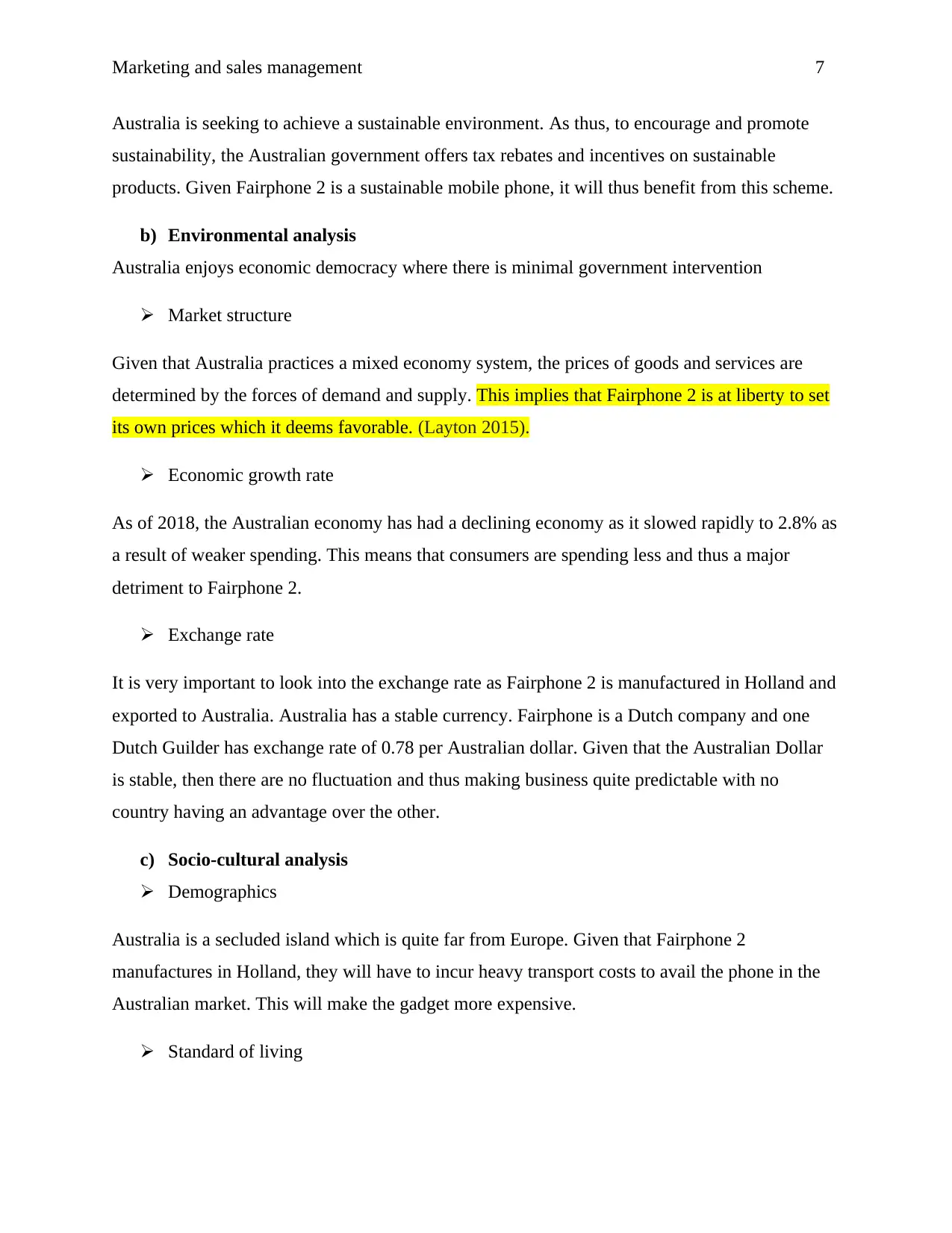
Marketing and sales management 7
Australia is seeking to achieve a sustainable environment. As thus, to encourage and promote
sustainability, the Australian government offers tax rebates and incentives on sustainable
products. Given Fairphone 2 is a sustainable mobile phone, it will thus benefit from this scheme.
b) Environmental analysis
Australia enjoys economic democracy where there is minimal government intervention
Market structure
Given that Australia practices a mixed economy system, the prices of goods and services are
determined by the forces of demand and supply. This implies that Fairphone 2 is at liberty to set
its own prices which it deems favorable. (Layton 2015).
Economic growth rate
As of 2018, the Australian economy has had a declining economy as it slowed rapidly to 2.8% as
a result of weaker spending. This means that consumers are spending less and thus a major
detriment to Fairphone 2.
Exchange rate
It is very important to look into the exchange rate as Fairphone 2 is manufactured in Holland and
exported to Australia. Australia has a stable currency. Fairphone is a Dutch company and one
Dutch Guilder has exchange rate of 0.78 per Australian dollar. Given that the Australian Dollar
is stable, then there are no fluctuation and thus making business quite predictable with no
country having an advantage over the other.
c) Socio-cultural analysis
Demographics
Australia is a secluded island which is quite far from Europe. Given that Fairphone 2
manufactures in Holland, they will have to incur heavy transport costs to avail the phone in the
Australian market. This will make the gadget more expensive.
Standard of living
Australia is seeking to achieve a sustainable environment. As thus, to encourage and promote
sustainability, the Australian government offers tax rebates and incentives on sustainable
products. Given Fairphone 2 is a sustainable mobile phone, it will thus benefit from this scheme.
b) Environmental analysis
Australia enjoys economic democracy where there is minimal government intervention
Market structure
Given that Australia practices a mixed economy system, the prices of goods and services are
determined by the forces of demand and supply. This implies that Fairphone 2 is at liberty to set
its own prices which it deems favorable. (Layton 2015).
Economic growth rate
As of 2018, the Australian economy has had a declining economy as it slowed rapidly to 2.8% as
a result of weaker spending. This means that consumers are spending less and thus a major
detriment to Fairphone 2.
Exchange rate
It is very important to look into the exchange rate as Fairphone 2 is manufactured in Holland and
exported to Australia. Australia has a stable currency. Fairphone is a Dutch company and one
Dutch Guilder has exchange rate of 0.78 per Australian dollar. Given that the Australian Dollar
is stable, then there are no fluctuation and thus making business quite predictable with no
country having an advantage over the other.
c) Socio-cultural analysis
Demographics
Australia is a secluded island which is quite far from Europe. Given that Fairphone 2
manufactures in Holland, they will have to incur heavy transport costs to avail the phone in the
Australian market. This will make the gadget more expensive.
Standard of living
Paraphrase This Document
Need a fresh take? Get an instant paraphrase of this document with our AI Paraphraser
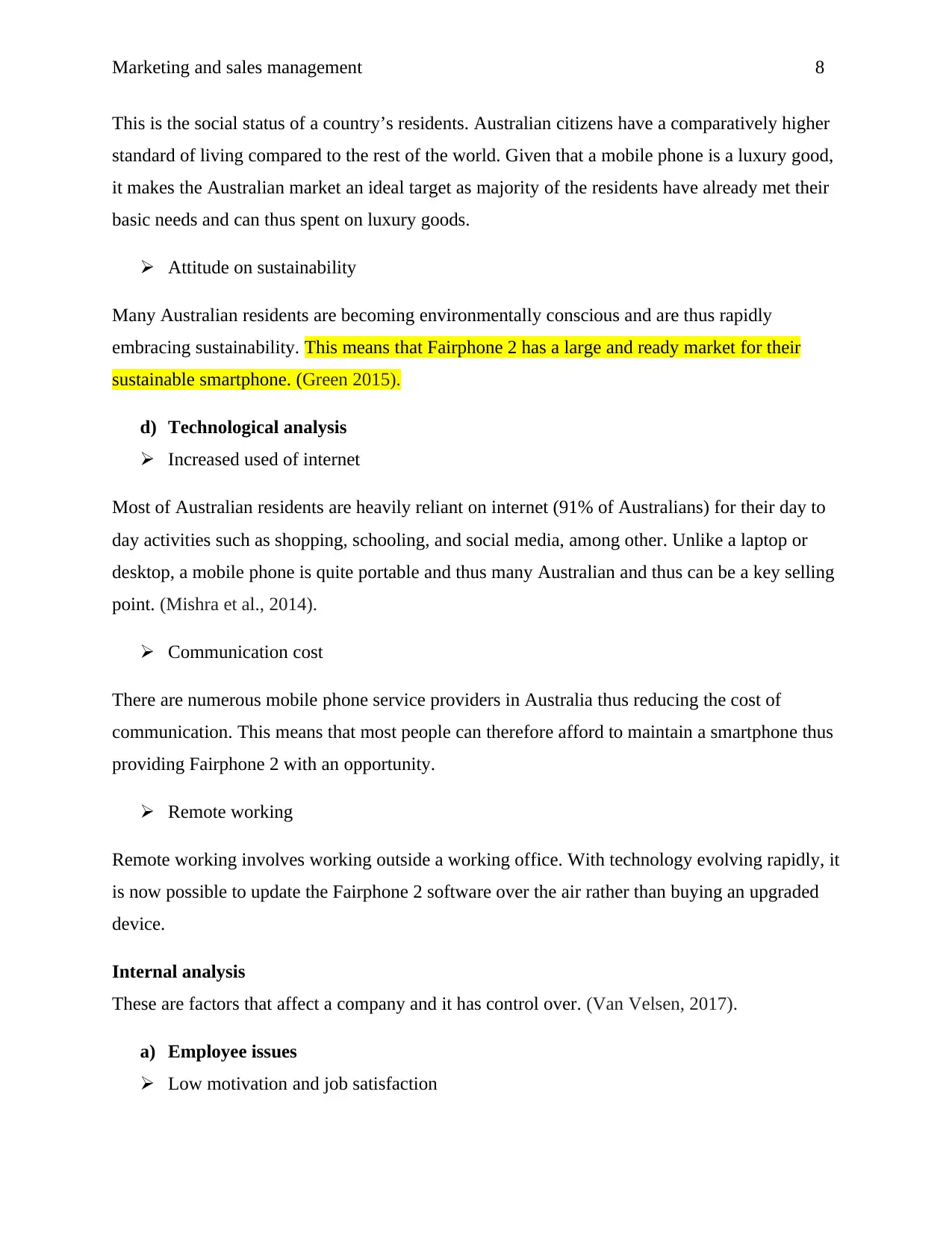
Marketing and sales management 8
This is the social status of a country’s residents. Australian citizens have a comparatively higher
standard of living compared to the rest of the world. Given that a mobile phone is a luxury good,
it makes the Australian market an ideal target as majority of the residents have already met their
basic needs and can thus spent on luxury goods.
Attitude on sustainability
Many Australian residents are becoming environmentally conscious and are thus rapidly
embracing sustainability. This means that Fairphone 2 has a large and ready market for their
sustainable smartphone. (Green 2015).
d) Technological analysis
Increased used of internet
Most of Australian residents are heavily reliant on internet (91% of Australians) for their day to
day activities such as shopping, schooling, and social media, among other. Unlike a laptop or
desktop, a mobile phone is quite portable and thus many Australian and thus can be a key selling
point. (Mishra et al., 2014).
Communication cost
There are numerous mobile phone service providers in Australia thus reducing the cost of
communication. This means that most people can therefore afford to maintain a smartphone thus
providing Fairphone 2 with an opportunity.
Remote working
Remote working involves working outside a working office. With technology evolving rapidly, it
is now possible to update the Fairphone 2 software over the air rather than buying an upgraded
device.
Internal analysis
These are factors that affect a company and it has control over. (Van Velsen, 2017).
a) Employee issues
Low motivation and job satisfaction
This is the social status of a country’s residents. Australian citizens have a comparatively higher
standard of living compared to the rest of the world. Given that a mobile phone is a luxury good,
it makes the Australian market an ideal target as majority of the residents have already met their
basic needs and can thus spent on luxury goods.
Attitude on sustainability
Many Australian residents are becoming environmentally conscious and are thus rapidly
embracing sustainability. This means that Fairphone 2 has a large and ready market for their
sustainable smartphone. (Green 2015).
d) Technological analysis
Increased used of internet
Most of Australian residents are heavily reliant on internet (91% of Australians) for their day to
day activities such as shopping, schooling, and social media, among other. Unlike a laptop or
desktop, a mobile phone is quite portable and thus many Australian and thus can be a key selling
point. (Mishra et al., 2014).
Communication cost
There are numerous mobile phone service providers in Australia thus reducing the cost of
communication. This means that most people can therefore afford to maintain a smartphone thus
providing Fairphone 2 with an opportunity.
Remote working
Remote working involves working outside a working office. With technology evolving rapidly, it
is now possible to update the Fairphone 2 software over the air rather than buying an upgraded
device.
Internal analysis
These are factors that affect a company and it has control over. (Van Velsen, 2017).
a) Employee issues
Low motivation and job satisfaction
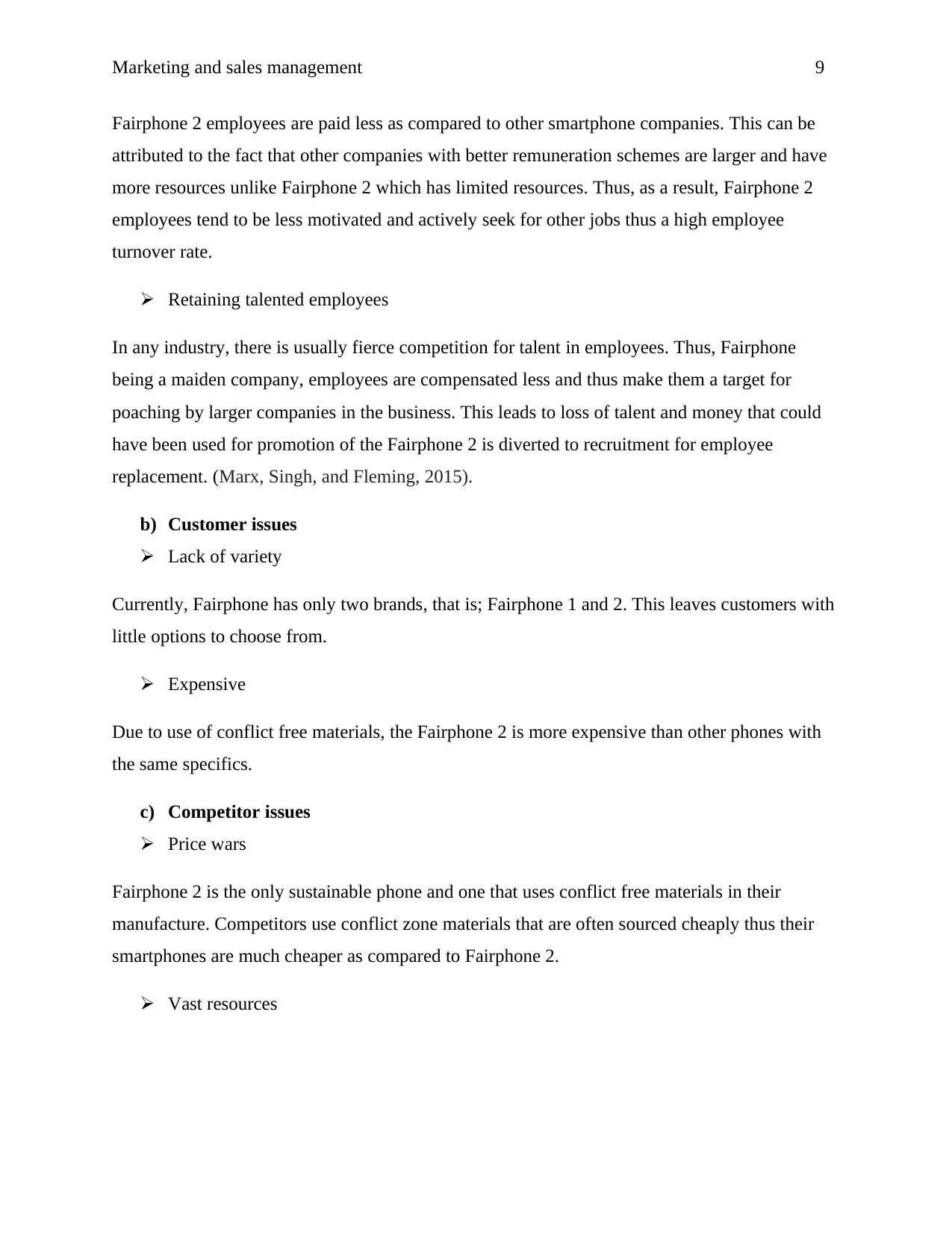
Marketing and sales management 9
Fairphone 2 employees are paid less as compared to other smartphone companies. This can be
attributed to the fact that other companies with better remuneration schemes are larger and have
more resources unlike Fairphone 2 which has limited resources. Thus, as a result, Fairphone 2
employees tend to be less motivated and actively seek for other jobs thus a high employee
turnover rate.
Retaining talented employees
In any industry, there is usually fierce competition for talent in employees. Thus, Fairphone
being a maiden company, employees are compensated less and thus make them a target for
poaching by larger companies in the business. This leads to loss of talent and money that could
have been used for promotion of the Fairphone 2 is diverted to recruitment for employee
replacement. (Marx, Singh, and Fleming, 2015).
b) Customer issues
Lack of variety
Currently, Fairphone has only two brands, that is; Fairphone 1 and 2. This leaves customers with
little options to choose from.
Expensive
Due to use of conflict free materials, the Fairphone 2 is more expensive than other phones with
the same specifics.
c) Competitor issues
Price wars
Fairphone 2 is the only sustainable phone and one that uses conflict free materials in their
manufacture. Competitors use conflict zone materials that are often sourced cheaply thus their
smartphones are much cheaper as compared to Fairphone 2.
Vast resources
Fairphone 2 employees are paid less as compared to other smartphone companies. This can be
attributed to the fact that other companies with better remuneration schemes are larger and have
more resources unlike Fairphone 2 which has limited resources. Thus, as a result, Fairphone 2
employees tend to be less motivated and actively seek for other jobs thus a high employee
turnover rate.
Retaining talented employees
In any industry, there is usually fierce competition for talent in employees. Thus, Fairphone
being a maiden company, employees are compensated less and thus make them a target for
poaching by larger companies in the business. This leads to loss of talent and money that could
have been used for promotion of the Fairphone 2 is diverted to recruitment for employee
replacement. (Marx, Singh, and Fleming, 2015).
b) Customer issues
Lack of variety
Currently, Fairphone has only two brands, that is; Fairphone 1 and 2. This leaves customers with
little options to choose from.
Expensive
Due to use of conflict free materials, the Fairphone 2 is more expensive than other phones with
the same specifics.
c) Competitor issues
Price wars
Fairphone 2 is the only sustainable phone and one that uses conflict free materials in their
manufacture. Competitors use conflict zone materials that are often sourced cheaply thus their
smartphones are much cheaper as compared to Fairphone 2.
Vast resources
⊘ This is a preview!⊘
Do you want full access?
Subscribe today to unlock all pages.

Trusted by 1+ million students worldwide
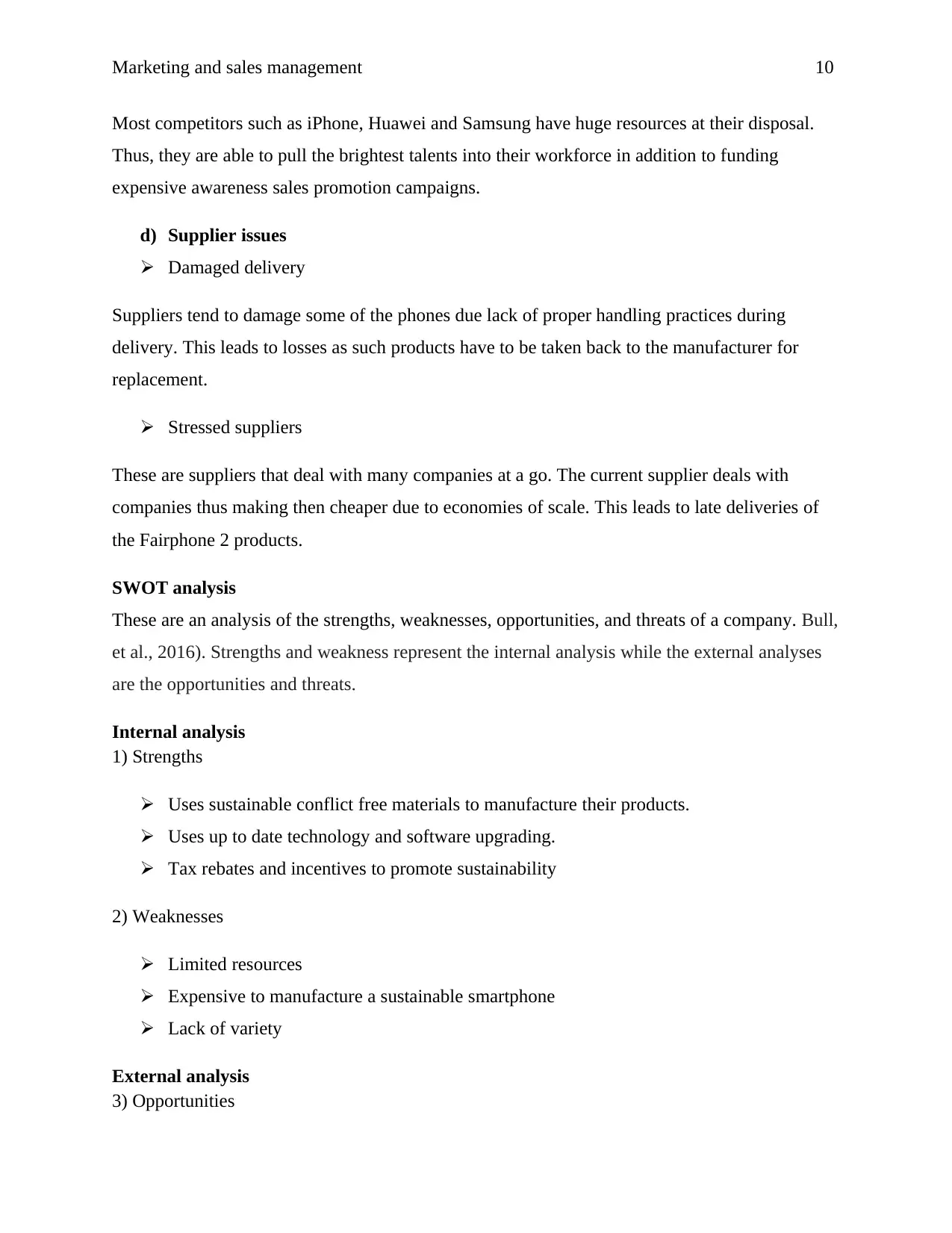
Marketing and sales management 10
Most competitors such as iPhone, Huawei and Samsung have huge resources at their disposal.
Thus, they are able to pull the brightest talents into their workforce in addition to funding
expensive awareness sales promotion campaigns.
d) Supplier issues
Damaged delivery
Suppliers tend to damage some of the phones due lack of proper handling practices during
delivery. This leads to losses as such products have to be taken back to the manufacturer for
replacement.
Stressed suppliers
These are suppliers that deal with many companies at a go. The current supplier deals with
companies thus making then cheaper due to economies of scale. This leads to late deliveries of
the Fairphone 2 products.
SWOT analysis
These are an analysis of the strengths, weaknesses, opportunities, and threats of a company. Bull,
et al., 2016). Strengths and weakness represent the internal analysis while the external analyses
are the opportunities and threats.
Internal analysis
1) Strengths
Uses sustainable conflict free materials to manufacture their products.
Uses up to date technology and software upgrading.
Tax rebates and incentives to promote sustainability
2) Weaknesses
Limited resources
Expensive to manufacture a sustainable smartphone
Lack of variety
External analysis
3) Opportunities
Most competitors such as iPhone, Huawei and Samsung have huge resources at their disposal.
Thus, they are able to pull the brightest talents into their workforce in addition to funding
expensive awareness sales promotion campaigns.
d) Supplier issues
Damaged delivery
Suppliers tend to damage some of the phones due lack of proper handling practices during
delivery. This leads to losses as such products have to be taken back to the manufacturer for
replacement.
Stressed suppliers
These are suppliers that deal with many companies at a go. The current supplier deals with
companies thus making then cheaper due to economies of scale. This leads to late deliveries of
the Fairphone 2 products.
SWOT analysis
These are an analysis of the strengths, weaknesses, opportunities, and threats of a company. Bull,
et al., 2016). Strengths and weakness represent the internal analysis while the external analyses
are the opportunities and threats.
Internal analysis
1) Strengths
Uses sustainable conflict free materials to manufacture their products.
Uses up to date technology and software upgrading.
Tax rebates and incentives to promote sustainability
2) Weaknesses
Limited resources
Expensive to manufacture a sustainable smartphone
Lack of variety
External analysis
3) Opportunities
Paraphrase This Document
Need a fresh take? Get an instant paraphrase of this document with our AI Paraphraser
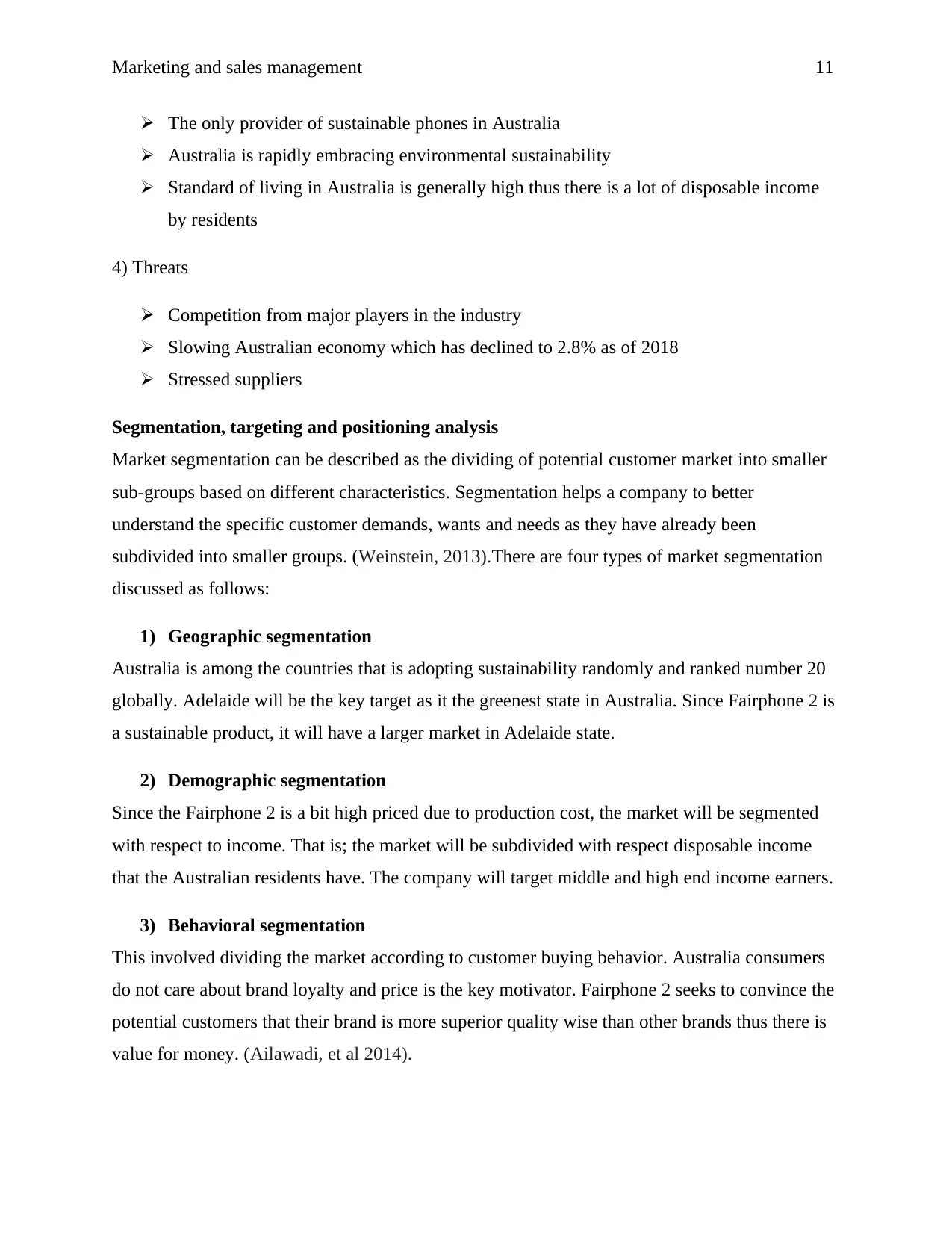
Marketing and sales management 11
The only provider of sustainable phones in Australia
Australia is rapidly embracing environmental sustainability
Standard of living in Australia is generally high thus there is a lot of disposable income
by residents
4) Threats
Competition from major players in the industry
Slowing Australian economy which has declined to 2.8% as of 2018
Stressed suppliers
Segmentation, targeting and positioning analysis
Market segmentation can be described as the dividing of potential customer market into smaller
sub-groups based on different characteristics. Segmentation helps a company to better
understand the specific customer demands, wants and needs as they have already been
subdivided into smaller groups. (Weinstein, 2013).There are four types of market segmentation
discussed as follows:
1) Geographic segmentation
Australia is among the countries that is adopting sustainability randomly and ranked number 20
globally. Adelaide will be the key target as it the greenest state in Australia. Since Fairphone 2 is
a sustainable product, it will have a larger market in Adelaide state.
2) Demographic segmentation
Since the Fairphone 2 is a bit high priced due to production cost, the market will be segmented
with respect to income. That is; the market will be subdivided with respect disposable income
that the Australian residents have. The company will target middle and high end income earners.
3) Behavioral segmentation
This involved dividing the market according to customer buying behavior. Australia consumers
do not care about brand loyalty and price is the key motivator. Fairphone 2 seeks to convince the
potential customers that their brand is more superior quality wise than other brands thus there is
value for money. (Ailawadi, et al 2014).
The only provider of sustainable phones in Australia
Australia is rapidly embracing environmental sustainability
Standard of living in Australia is generally high thus there is a lot of disposable income
by residents
4) Threats
Competition from major players in the industry
Slowing Australian economy which has declined to 2.8% as of 2018
Stressed suppliers
Segmentation, targeting and positioning analysis
Market segmentation can be described as the dividing of potential customer market into smaller
sub-groups based on different characteristics. Segmentation helps a company to better
understand the specific customer demands, wants and needs as they have already been
subdivided into smaller groups. (Weinstein, 2013).There are four types of market segmentation
discussed as follows:
1) Geographic segmentation
Australia is among the countries that is adopting sustainability randomly and ranked number 20
globally. Adelaide will be the key target as it the greenest state in Australia. Since Fairphone 2 is
a sustainable product, it will have a larger market in Adelaide state.
2) Demographic segmentation
Since the Fairphone 2 is a bit high priced due to production cost, the market will be segmented
with respect to income. That is; the market will be subdivided with respect disposable income
that the Australian residents have. The company will target middle and high end income earners.
3) Behavioral segmentation
This involved dividing the market according to customer buying behavior. Australia consumers
do not care about brand loyalty and price is the key motivator. Fairphone 2 seeks to convince the
potential customers that their brand is more superior quality wise than other brands thus there is
value for money. (Ailawadi, et al 2014).
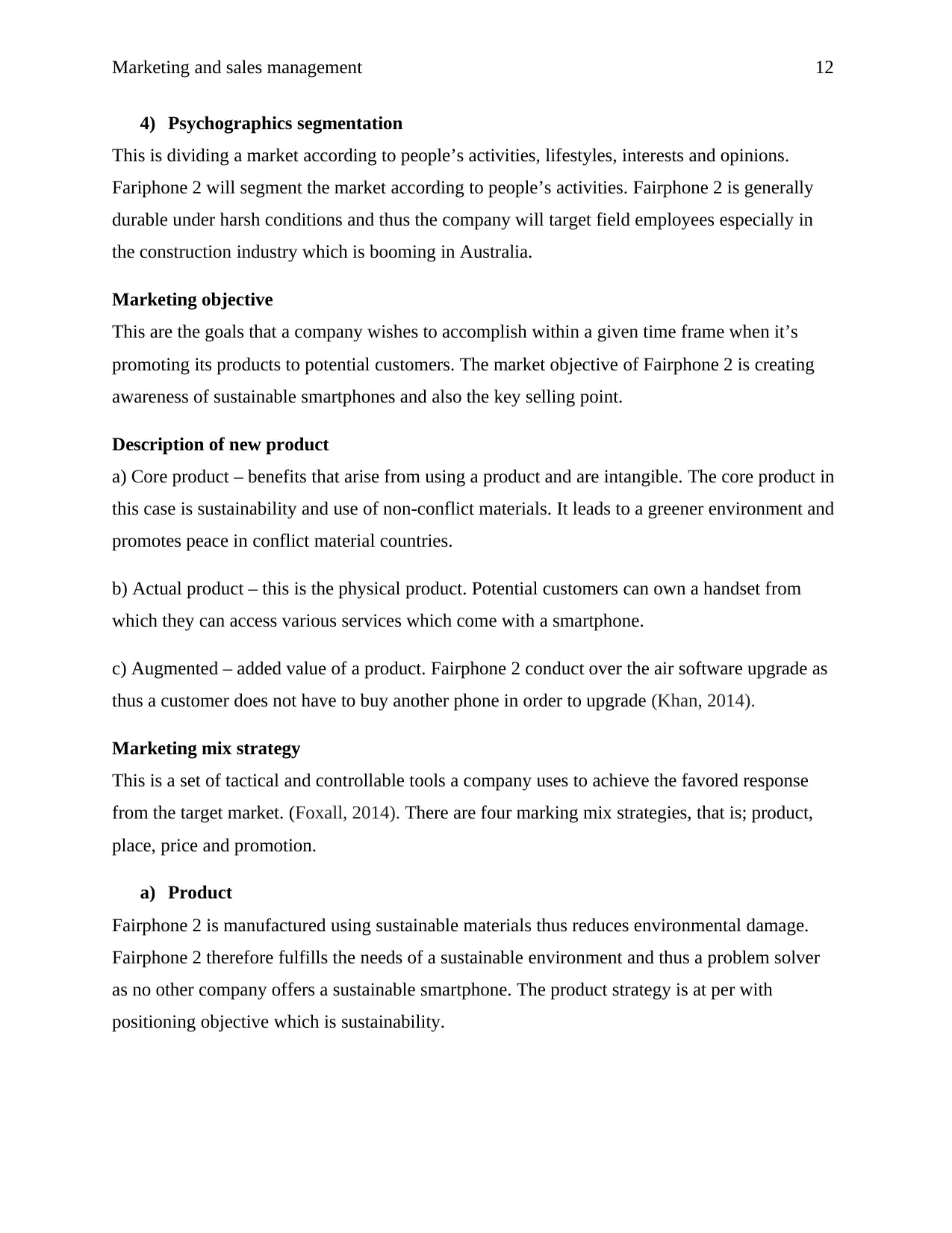
Marketing and sales management 12
4) Psychographics segmentation
This is dividing a market according to people’s activities, lifestyles, interests and opinions.
Fariphone 2 will segment the market according to people’s activities. Fairphone 2 is generally
durable under harsh conditions and thus the company will target field employees especially in
the construction industry which is booming in Australia.
Marketing objective
This are the goals that a company wishes to accomplish within a given time frame when it’s
promoting its products to potential customers. The market objective of Fairphone 2 is creating
awareness of sustainable smartphones and also the key selling point.
Description of new product
a) Core product – benefits that arise from using a product and are intangible. The core product in
this case is sustainability and use of non-conflict materials. It leads to a greener environment and
promotes peace in conflict material countries.
b) Actual product – this is the physical product. Potential customers can own a handset from
which they can access various services which come with a smartphone.
c) Augmented – added value of a product. Fairphone 2 conduct over the air software upgrade as
thus a customer does not have to buy another phone in order to upgrade (Khan, 2014).
Marketing mix strategy
This is a set of tactical and controllable tools a company uses to achieve the favored response
from the target market. (Foxall, 2014). There are four marking mix strategies, that is; product,
place, price and promotion.
a) Product
Fairphone 2 is manufactured using sustainable materials thus reduces environmental damage.
Fairphone 2 therefore fulfills the needs of a sustainable environment and thus a problem solver
as no other company offers a sustainable smartphone. The product strategy is at per with
positioning objective which is sustainability.
4) Psychographics segmentation
This is dividing a market according to people’s activities, lifestyles, interests and opinions.
Fariphone 2 will segment the market according to people’s activities. Fairphone 2 is generally
durable under harsh conditions and thus the company will target field employees especially in
the construction industry which is booming in Australia.
Marketing objective
This are the goals that a company wishes to accomplish within a given time frame when it’s
promoting its products to potential customers. The market objective of Fairphone 2 is creating
awareness of sustainable smartphones and also the key selling point.
Description of new product
a) Core product – benefits that arise from using a product and are intangible. The core product in
this case is sustainability and use of non-conflict materials. It leads to a greener environment and
promotes peace in conflict material countries.
b) Actual product – this is the physical product. Potential customers can own a handset from
which they can access various services which come with a smartphone.
c) Augmented – added value of a product. Fairphone 2 conduct over the air software upgrade as
thus a customer does not have to buy another phone in order to upgrade (Khan, 2014).
Marketing mix strategy
This is a set of tactical and controllable tools a company uses to achieve the favored response
from the target market. (Foxall, 2014). There are four marking mix strategies, that is; product,
place, price and promotion.
a) Product
Fairphone 2 is manufactured using sustainable materials thus reduces environmental damage.
Fairphone 2 therefore fulfills the needs of a sustainable environment and thus a problem solver
as no other company offers a sustainable smartphone. The product strategy is at per with
positioning objective which is sustainability.
⊘ This is a preview!⊘
Do you want full access?
Subscribe today to unlock all pages.

Trusted by 1+ million students worldwide
1 out of 17
Related Documents
Your All-in-One AI-Powered Toolkit for Academic Success.
+13062052269
info@desklib.com
Available 24*7 on WhatsApp / Email
![[object Object]](/_next/static/media/star-bottom.7253800d.svg)
Unlock your academic potential
Copyright © 2020–2025 A2Z Services. All Rights Reserved. Developed and managed by ZUCOL.





